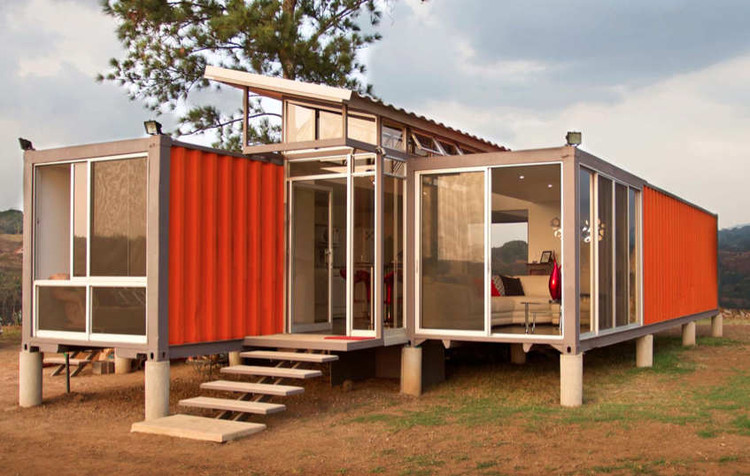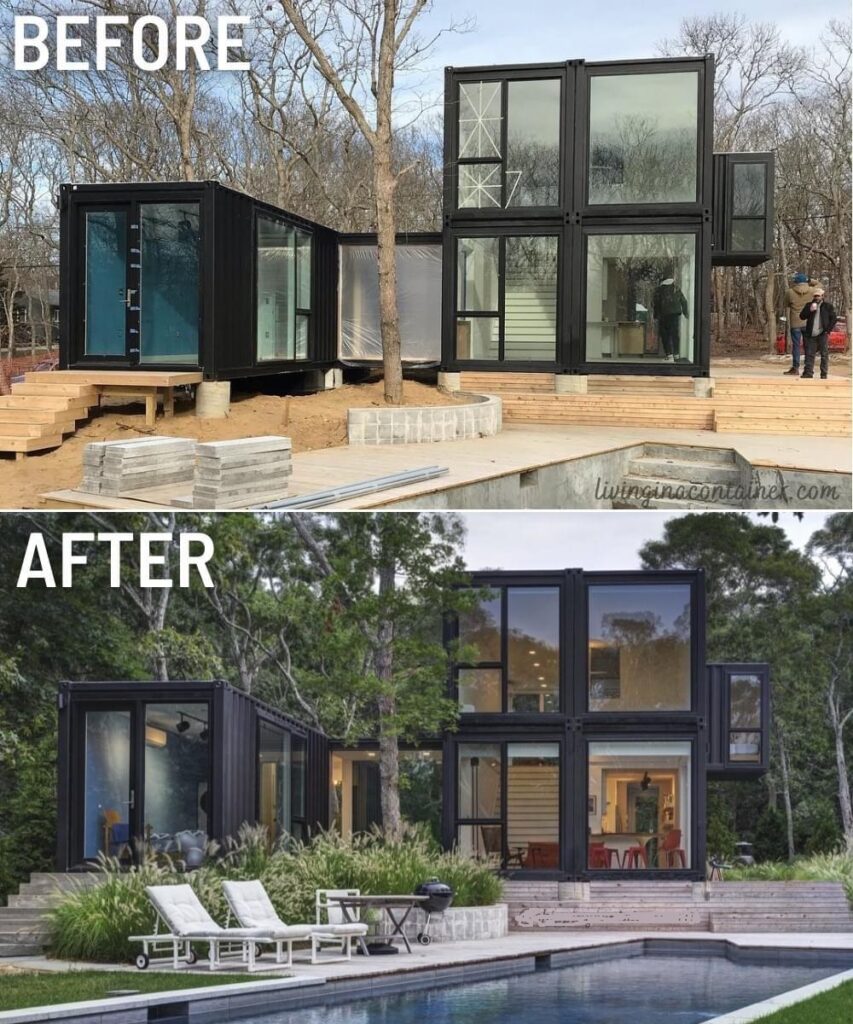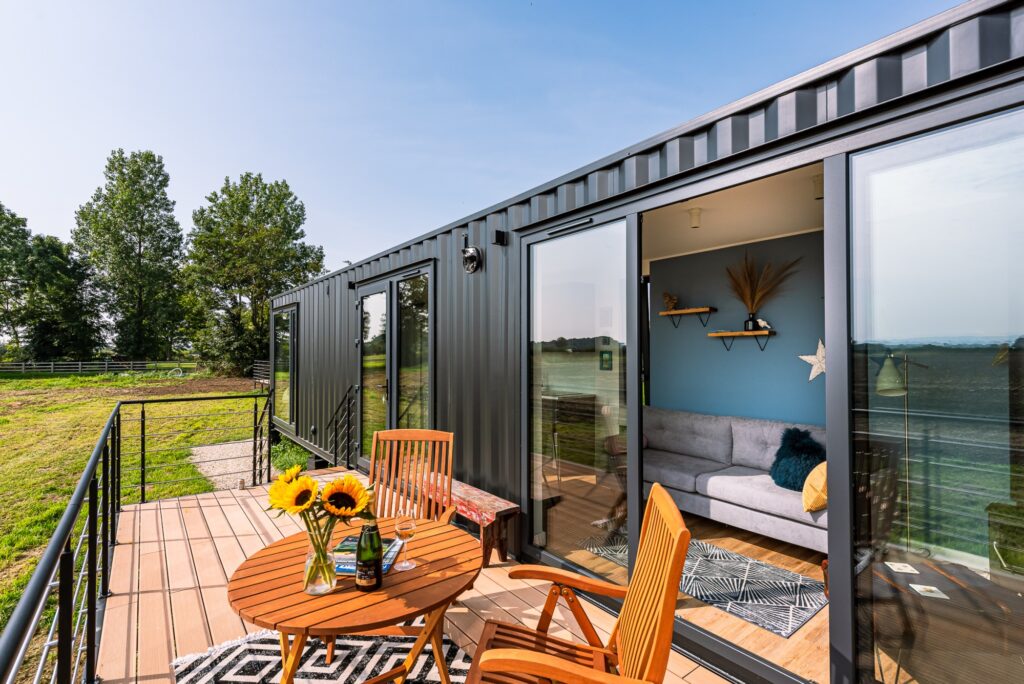The concept of building homes from shipping containers (container homes) may have begun as a quirky architectural trend, but it has since evolved into a practical and sustainable housing solution that captures the attention of homeowners, architects, and developers alike. This thorough guide explores every aspect of constructing homes using shipping containers, from their history to design options, construction processes, and environmental benefits, all while optimizing for search visibility to ensure that those seeking information on this innovative housing solution can find it easily.
Introduction to Shipping Container Homes
Shipping container homes are innovative structures that repurpose large steel containers used in global shipping into livable spaces. As an affordable and eco-friendly housing solution, shipping container homes can be designed to fit a variety of styles and needs. They are increasingly gaining popularity among people looking for alternatives to traditional housing, especially in a world where sustainability is becoming a priority.
The basic premise is simple: transform a standard shipping container—from a mundane vessel transporting goods across oceans into a cozy, stylish home. With proper insulation, ventilation, and design considerations, a shipping container can offer a unique living experience that many find appealing.
History of Shipping Container Architecture
The trend of using shipping containers as homes emerged in the early 2000s when architects began playing with the idea of converting them into livable spaces. The first instances of this concept can be traced back to small-scale projects that aimed to provide affordable and sustainable housing options. As raw materials became more expensive and the need for sustainable development grew, shipping containers offered a ready-made solution to the escalating housing crisis.
Notable early adopters of shipping container architecture included:
- The Container City Project (London, UK): Building community spaces and living units from shipping containers.
- The 1st Container House (Mexico City, Mexico): A simple, stylish shipping container house that introduced the idea to a broader audience.
These early successes helped to pave the way for what has become a worldwide phenomenon, with shipping container houses now appearing in urban and rural settings alike.
Benefits of Building Homes from Shipping Containers
1. Affordability
Shipping containers are generally inexpensive compared to traditional building materials. A used shipping container can range from $1,500 to $5,000, making it a budget-friendly option for many. Furthermore, the construction speed can significantly reduce overall labor costs.
2. Sustainability
Using shipping containers promotes recycling, as they are often repurposed from obsolete materials. The longevity of steel makes container homes durable, requiring less frequent replacement and reducing waste.
3. Modularity
Containers can be stacked and arranged in various configurations, allowing homeowners to create customized structures tailored to their needs. This modularity provides flexibility in design and scale.
4. Resilience
Shipping containers are designed to withstand harsh conditions at sea, making them remarkably robust. Properly modified containers can provide excellent protection against weather elements, pests, and potentially even natural disasters.
5. Aesthetic Versatility
With creativity, shipping container homes can reflect personal tastes and preferences. From modern minimalist to rustic styles, the potential for unique designs is endless.
Design Considerations for Container Homes
When designing a shipping container home, various factors must be taken into account to ensure comfort, aesthetic appeal, and practicality:
1. Insulation
Containers are made of steel, which can lead to extreme temperatures inside. Proper insulation is critical for maintaining a comfortable living environment. Options include spray foam insulation, rigid foam boards, and insulated panels.
2. Ventilation
To avoid moisture buildup and ensure fresh air circulation, integrating windows, doors, and ventilation systems within the design is important. Natural ventilation can be achieved using strategically placed operable windows.
3. Flooring and Walls
The interior space of shipping containers often requires modifications. Choosing the right flooring and wall materials is essential for both comfort and aesthetics. Wooden floors, ceramic tiles, or recycled materials can enhance the visual appeal.
4. Plumbing and Electrical Systems
Integrating plumbing and electrical systems into a shipping container home requires thoughtful planning. Ensure that the layout accommodates these systems effectively and meets local building codes.
5. Landscaping
Creating an inviting outdoor space can complement the container structure. Utilizing landscaping techniques can soften the industrial look and make the environment more pleasant.
The Construction Process
Constructing a container home can be divided into several stages:
1. Planning and Design
The initial phase involves determining the home’s layout, dimensions, and design elements. Seek advice from architects or builders specializing in container homes to refine the design.
2. Acquiring Containers
Purchase used or new shipping containers from reputable sources. Inspect them for structural integrity and signs of damage, especially rust.
3. Site Preparation
Prepare the land where the home will be placed. This may include clearing vegetation, leveling the ground, and laying a foundation, which can be concrete piers or a concrete slab.
4. Modifications and Construction
Containers need to be modified based on the design plan. This may involve cutting windows, insulating, wiring, plumbing, and reinforcing the structure as needed.
5. Finishing Touches
Once the rough construction is complete, focus on interior and exterior finishes. This includes selecting paint colors, installing cabinets and appliances, and landscaping the surrounding area.
6. Final Inspection
Before occupying the home, ensure that all construction meets local safety codes and regulations. A final inspection by local authorities may be necessary.
Key Challenges and Solutions
While shipping container homes offer many benefits, challenges often arise during construction and occupancy. These include:
1. Heating and Cooling
Due to the metal’s conductive nature, maintaining a stable temperature inside a container can be challenging. Solution: Invest in high-quality insulation and heating/cooling systems, such as mini-split air conditioning or radiant floor heating.
2. Building Codes
Shipping container homes may not conform to traditional building codes in many areas, which can create obstacles. Solution: Collaborate with knowledgeable local architects or builders who understand regulations and can help navigate the approval process.
3. Insurance Issues
Some insurance companies might be hesitant to insure non-traditional homes. Solution: Research insurers who specialize in unique properties and can offer appropriate coverage.
Building Codes and Regulations
Before embarking on the journey of creating a container home, it is crucial to understand that local building codes may differ widely. Regulations concerning the structural integrity of the building, zoning laws, and living arrangements must be adhered to. In many regions, shipping containers are classified differently than traditional homes, prompting extra considerations.
Common regulatory requirements may include:
- Zoning Laws: Confirms the property can be used for residential purposes.
- Permits: Required for construction, plumbing, and electrical work.
- Health and Safety Standards: Ensure secure living conditions.
Consulting with a local building authority or an architect who understands container living can save time and reduce potential complications.
Cost Analysis of Shipping Container Homes
The costs associated with building a home from shipping containers can vary significantly, depending on several factors. Here’s a summary breakdown of typical expenses:
1. Container Costs
Used containers can range from $1,500 to around $5,000 each, depending on their condition and location.
2. Land Costs
Expenses will obviously vary based on location. Ensure to account for land purchase, taxes, and preparation costs.
3. Utilities and Hookup Fees
Costs for connecting to public utilities—water, electricity, sewage—can be significant depending on proximity.
4. Labor Costs
Although container construction can be done DIY-style, skilled labor may still be required for plumbing, electrical work, and structural renovations.
5. Interior Finishes
Basic interior finishes (kitchen appliances, bathroom fixtures, insulation, drywall) can be costly, often running thousands of dollars, depending on quality choices and customization.
Budgeting well and creating a detailed plan will help in managing costs effectively.
Sustainability and Environmental Impact
Building homes from shipping containers is a sustainable choice that positively impacts the environment. Here’s how:
1. Recycling Materials
Repurposing containers saves them from the landfill, contributing to a reduction in industrial waste.
2. Reduced Construction Waste
Constructing with containers generates less waste than traditional building methods since they use a pre-made structure.
3. Energy Efficiency
With proper insulation and energy-efficient systems, container homes can minimize utility use, resulting in lower greenhouse gas emissions.
4. Promoting Sustainable Living
The allure of container homes often lies in their affordability and reduced ecological footprint, encouraging and enabling individuals to adopt more sustainable lifestyles.
Finding the Right Professionals
Selecting the right professionals for your shipping container home project is crucial. Here’s how to approach this:
1. Research and Referrals
Seek out architects and builders with experience in shipping container construction. Collect recommendations and reviews from previous clients.
2. Interviews and Consultations
Meet potential contractors, discuss your vision, and gauge their knowledge of container homes to ensure they align with your project needs.
3. Review Portfolios
Look at past projects to get a sense of each professional’s style and competence. Pay attention to completed container homes or similar modular projects. Asis reefer trailer
Case Studies of Successful Container Homes
Understanding how others have successfully utilized shipping containers for housing can be motivating and informative.
1. The MODULUS House (Portland, Oregon)
This contemporary home uses several shipping containers arranged artfully, showing how unique designs can create stunning living spaces.
2. Container Guest House (Maui, Hawaii)
A great example of utilizing shipping containers for short-term rental purposes, this guest home blends seamlessly with the surrounding landscape.
3. The Cargotecture Project (Los Angeles, California)
This project showcases the versatility and beauty of container homes, creating stylish urban living spaces while maintaining functionality.
Future Trends in Shipping Container Homes
As conservation and sustainable living practices become more mainstream, the future of shipping container homes looks promising. Upcoming trends include:
1. Increased Customization Options
Companies focusing on customizable container home designs are growing, with innovative floor plans, eco-friendly materials, and smart home features.
2. Community Developments
Growing popularity for container homes has led to more modular communities, combining multiple units to create neighborhood spaces.
3. Technological Integration
Future homes may see smarter environmental control systems, energy-efficient appliances, and advanced insulation materials that ensure optimal conditions.
4. Global Adoption
Container homes are expanding beyond Western countries, with new markets emerging in developing regions, showcasing affordable and rapid housing solutions in response to local housing crises.
Conclusion
Building homes from shipping containers presents a remarkable opportunity for affordable, sustainable living. As this innovative housing solution continues to gain traction, it will undoubtedly shape the future of architectural practices and urban development. Embracing the myriad benefits that container homes offer—combined with an understanding of the associated challenges and local regulations—enables prospective homeowners to turn an unconventional dream into a reality.
Explore this exciting frontier of container architecture, whether through DIY projects, custom builds, or community houses. The opportunities are endless, and the outcome has the potential to revolutionize the way we think about housing!
This in-depth guide aims to provide valuable insights into building homes from shipping containers, ensuring anyone embarking on this journey is well-informed and inspired. By adhering to SEO best practices with rich, engaging content, this post also strives to rank prominently in search engines, attracting those interested in this sustainable living trend.






